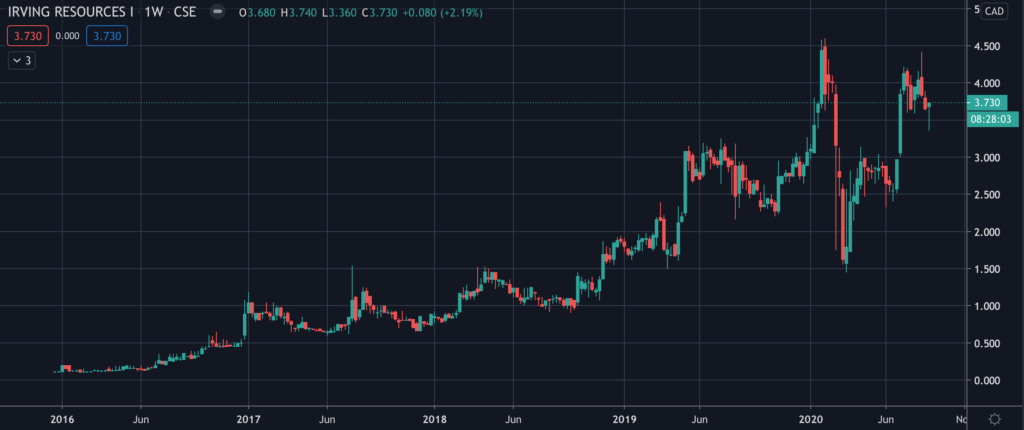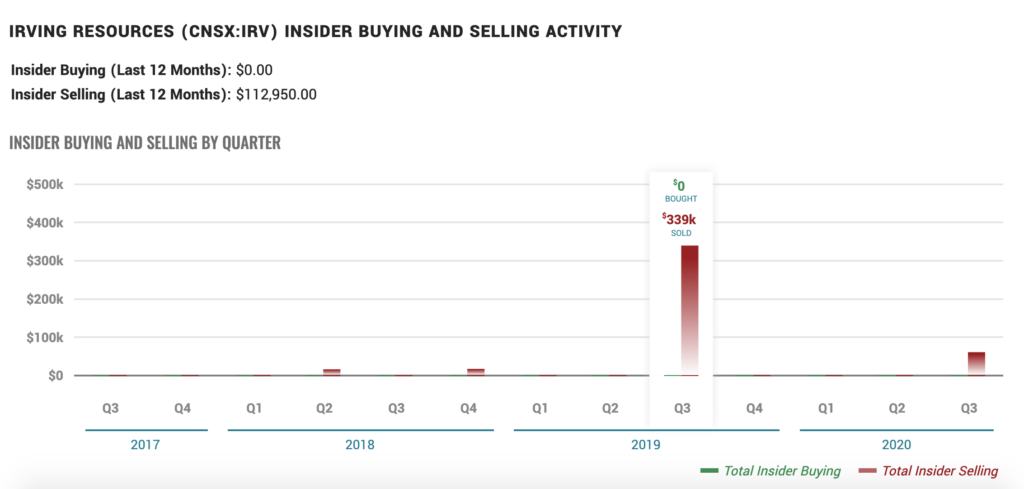Common Stock: Irving Resources (IRV)
Current Market Price: $3.73 CAD
Market Capitalization: $204.4 million CAD
**Note: All values in this article are expressed in Canadian Dollars (CAD) unless otherwise noted.

Irving Resources Stock – Summary of the Company
Irving Resources is a gold exploration company focused on the acquisition, exploration and development of gold properties in Japan. They own several exploration stage projects in Japan and through a subsidiary have interests in Africa as well. Irving was founded in 2015 and is headquartered in Vancouver Canada.
Revenue and Cost Analysis
Irving Resources does not have any properties that are currently producing and therefore does not have any revenue. The company consistently runs a net loss and is likely to continue to do so for the foreseeable future.
The company had a net loss of $3.3 million for the fiscal year 2019. Their largest expenses were compensation related, including share based compensation.
Irving Resources – Royalty and Streaming Agreements
The is no mention of any royalty or streaming agreements in the company’s most recent audited annual financial report.
Balance Sheet Analysis
Irving has a sound balance sheet with strong liquidity and low liability levels.
Irving Resources – Debt Analysis
As of February 2020, the company does not have any debt outstanding.
Irving Resources Stock – Share Dynamics and Capital Structure
As of August 2020, the company has 57.2 million common shares outstanding. They also have a small amount of options and warrants outstanding. Fully diluted shares outstanding is around 61 million shares.
Irving does not have an overly dilutive capital structure and is acceptable for common shareholders.
Irving Resources Stock – Dividends
The company does not pay a dividend and is unlikely to do so for the foreseeable future.
Management – Skin in the game
Insiders at Irving Resources have been net sellers of the company’s stock over the past 12 months. This is generally viewed as a bearish signal.

Irving Resources Stock – 3 Metrics to Consider
Debt to Equity Ratio
Total Liabilities/Total Share Holder Equity
$1.4 million/$26 million = .05
A debt to equity ratio of .05 implies that Irving uses almost no debt in its capital structure and relies almost entirely on equity financing to fund itself.
Working Capital Ratio
Current Assets/Current Liabilities
$13.1 million/ $1.3 million = 9.7
A working capital ratio of 9.7 implies a strong liquidity position. Irving should not have a problem meeting its short-term obligations.
Price to Book Ratio
Current Share Price/Book Value per Share.
$3.73/$.43
Based on fully diluted shares outstanding Irving has a book value per share of $.43. At the current market price this implies a price to book ratio of 8.7, meaning the company’s stock trades at a significant premium to the book value of the company.
Gold Market – Economic Factors and Competitive Landscape
Gold mining is a highly competitive, capital intensive business. The company will need to compete fiercely for both new projects and capital. However, given the current economic environment of global money printing and zero or negative interest rates, it would appear gold companies are poised to benefit from a strong economic tailwind.
Irving Resources Stock – Summary and Conclusions
Irving may or may not have promising exploration properties, I’m not sure. The company is sound financially and their share structure is not overly dilutive.
However, I don’t know anything about mining in Japan. In addition, Japan’s longest serving leader (post war), Shinzo Abe, has resigned the day of this article (August 28, 2020). For that reason, I will not invest in Irving Resources stock, as I would prefer to allocate to projects where I am more knowledgeable, such as Marathon Gold.
Disclaimer
This is not investment advice. Nothing in this analysis should be construed as a recommendation to buy, sell, or otherwise take action related to the security discussed. If I own a position in the security discussed, I will clearly state it.
This is not intended to be a comprehensive analysis and you should not make an investment decision based solely on the information in this analysis. I hope this serves as a useful starting point for a more comprehensive analysis, and hopefully draws attention to aspects of the company that were overlooked or merit further investigation. This is by no means intended to be a complete analysis. Again, this is not investment advice, do your own research.